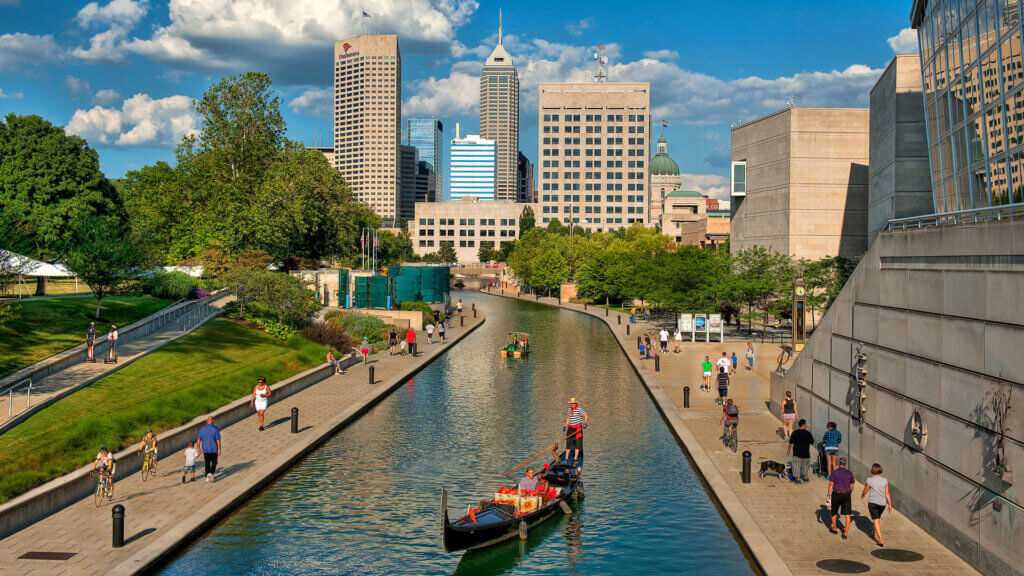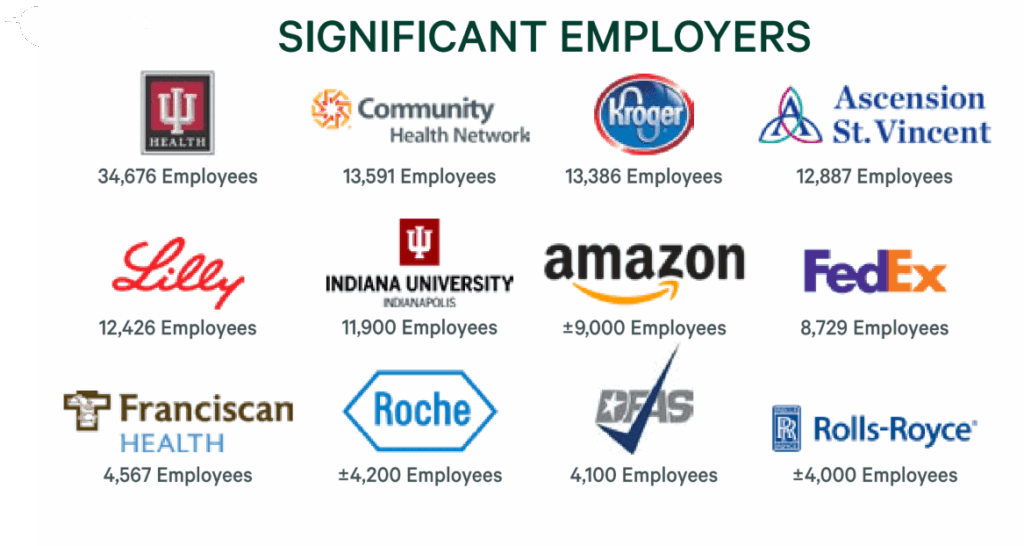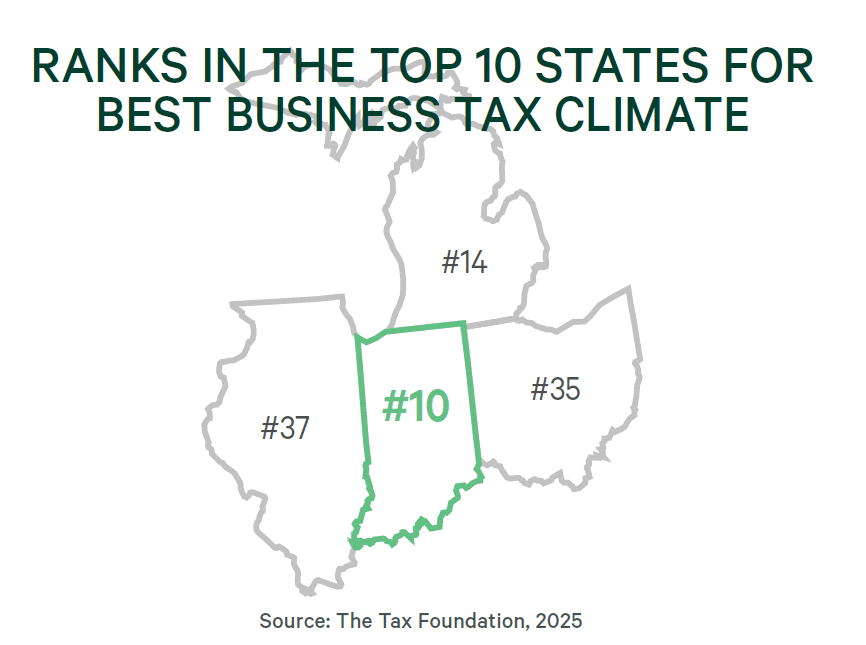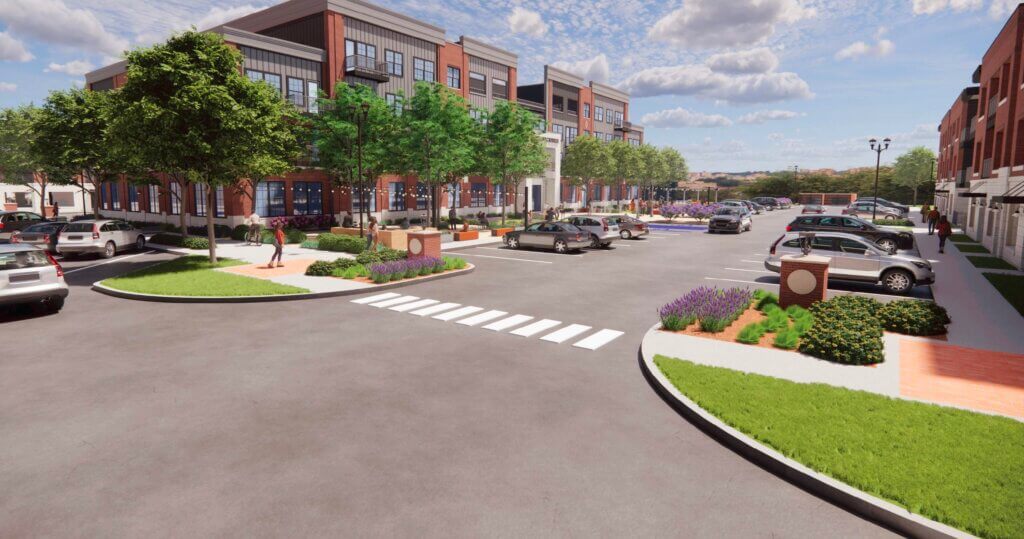Why August Is the Perfect Time to Review Your Real Estate Strategy

Indianapolis has rapidly become a premier destination for passive real estate investors seeking strong returns, stability, and growth. The city’s fundamentals are hard to match in the Midwest or beyond.
Indianapolis is the largest city in Indiana and the 15th largest in the U.S. The metropolitan area’s population has grown steadily for more than a decade, with the most recent estimates placing the metro at over 2.1 million residents. This growth is driven by a combination of affordability, job creation, and a high quality of life.
The job market in Indianapolis is anchored by several Fortune 500 and major regional employers. Eli Lilly and Company, one of the world’s largest pharmaceutical firms, employs more than 10,000 people locally. Salesforce has its largest regional hub in the Salesforce Tower downtown, and IU Health is the state’s largest health system with thousands of employees. The city’s employment base is diversified across healthcare, life sciences, logistics, advanced manufacturing, and technology, reducing risk for real estate investors.
Indianapolis also boasts a cost of living that is about 10-15% below the national average, making it attractive to both employers and residents. Median rents are considerably lower than in peer cities such as Chicago or Nashville, yet rent growth remains strong due to increasing demand and limited new supply.
For passive investors in Indiana real estate, these factors combine to create a market with high occupancy, stable cash flow, and long-term appreciation potential.

The multifamily sector in Indianapolis is in the midst of a transformation, driven by population growth, job creation, and lifestyle shifts.
Rent Growth:
Over the past year, Indianapolis has seen average rent growth of 4.2%, outpacing both the Midwest and the national average. This is driven by strong demand from young professionals, families, and downsizing baby boomers.
Vacancy Rates:
Vacancy rates in Indianapolis multifamily properties remain tight, hovering around 5.3% according to CoStar and REIS data. This is well below the national average, reflecting healthy tenant demand and limited overbuilding.
New Construction Pipeline:
There are currently over 6,000 new multifamily units under construction or in the pipeline for delivery by 2026. Most new development is concentrated in high-demand submarkets such as downtown, Broad Ripple, Fishers, and Carmel, as well as near major employment and education centers. 6,000 new multifamily seems like a lot, however, 5,351 units were quickly absorbed in 2024 which proves there is extremely strong demand for apartments throughout Indianapolis, Indiana.
Demand Drivers:
Indianapolis is home to a diverse and stable employment base, anchored by major healthcare, education, logistics, and manufacturing employers!

Leading the region is IU Health with over 34,000 employees, followed by Community Health Network, Kroger, and Ascension St. Vincent, each employing over 12,000 people.
The city also benefits from the presence of Eli Lilly, Indiana University, Amazon, and FedEx, providing a balanced mix of healthcare, education, e-commerce, and distribution jobs. Additionally, companies like Roche, Rolls-Royce, and Franciscan Health further bolster the metro’s employment diversity, supporting long-term rental demand and economic resilience — key fundamentals for passive multifamily investors.
Passive investors are increasingly drawn to Indianapolis for several compelling reasons:

Indiana ranks among the top 10 states in the nation for best business tax climate, according to The Tax Foundation’s 2025 report. With a #10 ranking, the state outperforms neighboring markets like Ohio (#35), Illinois (#37), and Michigan (#14). This favorable tax environment makes Indiana an attractive destination for business growth, job creation, and real estate development — offering multifamily investors a competitive edge in a pro-business, economically stable market.
Want to learn more about our investment approach? Visit our How It Works section.
| Metric | Value | Source |
|---|---|---|
| MSA Population (2024) | 2,143,859 | STATS Indiana |
| City Population (2024) | 900,896 | STATS Indiana |
| Median Household Income (2023) | $62,995 | U.S. Census Bureau |
| Unemployment Rate (March 2025) | 3.5% | YCharts |
| 12-Month Rent Growth (2024) | 3.3% | CBRE |
| Average Rent (Q4 2024) | $1,274 | CBRE |
| Vacancy Rate (2024) | 9.8% | The Kirkland Company |
| Multifamily Cap Rate (End of 2024) | 5.05% | Apartment Loan Store |
| Labor Force Growth (Aug 2023–Aug 2024) | 1.3% | Indiana Business Research Center |
| Cost of Living Index (2025) | 11% below national average | RentCafe |
| Average Apartment Size for $2,000 Rent | 1,333 sq ft | Axios |
| Net Absorption (2024) | 5,351 units | Colliers |
| Occupancy Rate (Q4 2024) | 93.5% | Berkadia |

Goodin Development is a locally based multifamily development firm headquartered in Indianapolis, Indiana.
We specialize in ground-up, Class A apartment communities built for long-term value in thriving Indiana markets. As local developers, we know this state better than anyone — from the fastest-growing suburbs to the overlooked tertiary towns with untapped potential.
Our team lives and works here, and we invest exclusively throughout Indiana. For passive real estate investors, Goodin Development offers a focused, market-specific investment strategy led by a team with deep local expertise and a proven track record.
If you’re looking for a trusted partner with homegrown knowledge and a sharp eye for opportunity in Indiana, we’re your team.
For more details on our current and past projects, see our multifamily developments page.

Investing passively in Indianapolis multifamily real estate with Goodin Development is straightforward and transparent:
Free Resource:
Sign up for our free 7-day email course, “Passive Real Estate Investing 101,” and learn how passive investing works, what to look for in a sponsor, and how to evaluate opportunities.
What returns can passive investors expect in Indianapolis?
Passive investors in Indianapolis multifamily syndications typically target annual cash-on-cash returns of 5–8%, with total project IRRs (Internal Rate of Return) in the 15–20% range over a 3–7 year hold period. Actual results vary by project and market conditions. Please keep in mind that the projected returns on any project are never promised or guaranteed.
How stable is the Indianapolis rental market?
The Indianapolis rental market has proven resilient through economic cycles, with consistent population growth, job creation, and a diversified economy. Vacancy rates remain below the national average, and rent growth has been steady.
Why invest passively instead of directly owning rentals here?
Passive investing allows you to benefit from real estate ownership without the day-to-day management headaches. You gain access to larger, professionally managed properties and diversified portfolios, while leveraging the expertise of experienced operators like Goodin Development.
Why does Goodin Development focus on Indiana markets?
As a local firm based in Indianapolis, we know these markets intimately. Our boots-on-the-ground presence and long-standing relationships with city officials, lenders, contractors, and brokers give us a strategic advantage in sourcing opportunities and navigating approvals efficiently. Additionally, we like to be within a few hours driving distance to all of our projects. During construction and throughout the hold period, we visit our properties several times a week.
Is Indianapolis a good market for passive real estate investors?
Yes — Indianapolis consistently ranks as one of the most stable and affordable multifamily markets in the Midwest. The city offers steady job growth, a diverse economy, and lower-than-average vacancy rates. Rent growth has remained healthy, even through national economic shifts, making it an attractive option for passive investors seeking predictable cash flow and long-term appreciation. The city’s business-friendly policies and affordable cost of living further enhance its appeal to real estate investors nationwide.
What are the best cities in Indiana for multifamily investing?
Beyond Indianapolis, several Indiana markets offer excellent multifamily investment potential. Fishers, Carmel, and Westfield are high-growth suburbs within the Indianapolis MSA with strong household incomes and rent demand. Lebanon, Kokomo, and Evansville are all growing markets with solid cash flow opportunities and less institutional competition. Investors should focus on areas with population growth, job creation, and landlord-friendly regulations — all of which Indiana markets tend to offer.
Is Indiana a landlord-friendly state for real estate investors?
Yes — Indiana is consistently ranked as one of the most landlord-friendly states in the U.S. The state provides clear, enforceable lease agreements and straightforward eviction processes, often allowing landlords to regain possession within 30 days for non-payment. Additionally, there are no rent control laws, and property owners enjoy strong protections under state law, making it an ideal environment for both active and passive real estate investors.
What are the tax benefits of investing in multifamily syndications?
Passive investors in multifamily syndications enjoy several attractive tax advantages. These include depreciation deductions, which can offset a portion of investment income, and cost segregation studies that accelerate depreciation benefits in the early years. Investors may also benefit from capital gains treatment on profits after a property sale and the potential to defer taxes through a 1031 exchange. Additionally, passive losses from real estate can often offset other passive income, improving overall tax efficiency.
What is the typical hold period for passive multifamily investments?
Most passive multifamily syndications target a hold period of 3 to 7 years. This allows operators to stabilize the property, increase rents, optimize expenses, and create appreciation before refinancing or selling. Some development deals may have slightly longer hold periods due to construction timelines, while value-add projects might exit sooner if market conditions are favorable. It’s important for investors to review projected timelines for each specific offering.
What is the minimum investment for a real estate syndication in Indiana?
The typical minimum investment for a multifamily syndication in Indiana ranges from $50,000 to $100,000 per offering. However, this can vary depending on the size of the project, sponsor preference, and whether the syndication is structured under Regulation D 506(b) or 506(c). At Goodin Development, our minimum investments start at $50,000, designed to make passive investing accessible to busy professionals looking to diversify their portfolios.
What are the advantages of investing with a local company in Indiana?
Investing with a local development firm like Goodin Development offers significant advantages. As local operators, we have in-depth market knowledge, on-the-ground relationships, and a clear understanding of regional trends. This allows us to source off-market opportunities, navigate city planning processes, and optimize construction and management operations. Local expertise often results in better project execution, risk management, and communication — all crucial for passive investors seeking dependable returns in Indiana real estate.
How do property taxes in Indiana compare to other real estate markets?
Indiana offers one of the most favorable property tax environments for real estate investors in the country. The state enforces property tax caps that limit the amount of property taxes based on property type:
These caps create predictability and control operating expenses for multifamily investors. Even in the event of voter-approved referendums that can raise local taxes, Indiana’s rates remain well below national averages. Compared to higher-tax states like Illinois or Michigan, this provides a meaningful advantage in both cash flow and long-term investment returns for passive real estate investors.
Goodin Development is the trusted partner for busy professionals seeking passive income and long-term growth in Indianapolis multifamily real estate. Join our investor list today for exclusive access to the best deals in the market.
This site is protected by reCAPTCHA and the Google Privacy Policy and Terms of Service apply.
Web design by Webisserie
No Offer of Securities—Disclosure of Interests. Under no circumstances should any material on this site be used or be considered as an offer to sell or as a solicitation of any offer to buy an interest in any investment. Any such offer or solicitation will be made only by means of the confidential private offering memorandum relating to the particular investment. Access to information about the investments are limited to investors who either qualify as accredited investors within the meaning of the Securities Act of 1933, as amended, or those investors who generally are sophisticated in financial matters, such that they are capable of evaluating the merits and risks of prospective investments. Past performance is not indicative of future results. All investments have risk and we strongly recommend you seek professional guidance before making any investment.